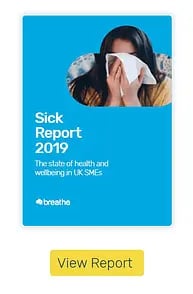Mental Health in the Workplace Guide
Download PDF
.webp?width=1200&height=632&name=Mental%20health%20guide%202021%20updated%20web%20thumbnail-min%20(1).webp)
The case for mental health awareness has stormed the headlines over recent years. You only need to look as far as campaigns such as Time To Change and Mental Health Awareness Week.
And this campaigning and awareness has never been so important: recent research by mental health charity, Mind, found in any given week in England, 1 in 6 of us struggle with our mental health. Horrifyingly, that’s around 9.2 million of us.
The topic of mental health is becoming an increasingly big part of the workplace wellbeing conversation. And this is no surprise – The Breathe Sick Report 2019 found that out of 32,568 million sick days taken in the SME sector during the last year, mental illness was the culprit for an astonishing 58% of them.
And the shocking statistics don’t stop there: we also discovered that burnout is costing the UK economy £1.4 billion a year through unexplained sick days – needless to say it’s a business issue as much as it is a health one.
Unsurprisingly, Covid-19 has impacted our mental health even more. The ONS found a staggering 1 in 5 adults reported symptoms of depression in the quarter leading to the 5th May 2021 compared to 1 in 10 before the pandemic. What’s more, over a half of adults and young people without prior mental health problems said their mental health got worse during the pandemic.
Promoting mental wellness in the workplace is essential if you’re striving to build and maintain a happy, productive workforce that is set to grow. And we’ll take a wild guess and say that growth is on your to-do list.
So, we’ve put together this comprehensive guide to give you 10 powerful practical steps you can apply within your business. These steps will help you support your employees’ mental health, invest in their wellbeing and, ultimately, sky- rocket productivity.
Let’s dig in.

If you want to know how you can build on the support you’re offering for mental health, a great place to start is by looking at what you’re already doing.
What measures do you currently have in place to support mental health? What are you doing well and what could you improve?
By assessing where you are currently, you’ll know which areas need focusing on.
As well as asking yourself these questions, it may also be a good idea to approach your people. An effective way of doing this is by creating a survey - you’ll be able to get direct, honest opinions on what you’re currently doing to support mental health in the workplace, as well as what you need to do to improve.
The Mind Workplace Wellbeing Index might be an option for you to consider. You can find out more and register here.
And, with productivity increasing by 12% in workplaces where mental wellbeing is addressed, just taking that first step can benefit your people (and your business, too).

Next is an incredibly important step.
Mental health is too often that big elephant in the room that everyone avoids discussing. Which - considering 1 in 4 of us experience mental health problems each year - is ludicrous.
And this can be a vicious circle: if employers are unsure of how to approach mental health and avoid the subject completely, employees may feel afraid of opening up to them about their struggles. And, if employees aren’t talking about their mental health, employers won’t learn how to approach it. Go figure.
Not to mention that it can be twice as difficult - especially in today’s world, when prejudices are still rife – to open up about mental health as an employee. It can be an incredibly scary step, mainly because of the uncertainty of how it could be received by their employer. Those who are struggling may fear being judged or maybe even that they could be perceived differently on a professional level because of their mental health problems.
But it all starts with you, their employer. You have the power to combat this by educating your workforce and starting the discussion - thus making it easier to speak up about mental health struggles.
Here are some ideas to help you get started:
The Breathe Sick Report 2019 found that only a third (34%) of employees feel comfortable calling in sick to their current employer for mental health reasons. But it doesn’t have to be this way; by developing a culture of openness you’ll help your employees feel comfortable enough to discuss their mental health issues with you, should they be struggling.
 Communication between you and your employees need to be a two-way street when it comes to mental health. You should encourage your staff to be open and honest with you. Let them know that if they’re having a bad day they should speak out and not suffer in silence.
Communication between you and your employees need to be a two-way street when it comes to mental health. You should encourage your staff to be open and honest with you. Let them know that if they’re having a bad day they should speak out and not suffer in silence.
Equally, making the first move and regularly checking in on your staff can be a great way to encourage open communication and normalise the topic of mental health as a whole.
Make sure communication methods are seamless. Establish an ‘open-door policy’ to let your employees know you’re always available should they need to talk. Schedule regular one-to-ones to catch up with employees, check in on them and give them regular opportunities to talk about things on their mind.
Download the full guide to discover more steps you can take to support your team's mental health.
It's completely free.
Start your free trial now
.webp?width=535&name=Smiley%20Lady%20with%20cloud@2x%20(1).webp)